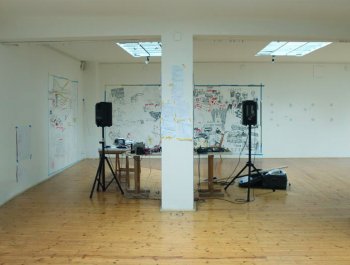curator: Veronika Resslová
During the opening, Ewa Justka will perform.
Summer is not the most suitable season for art shows, with everyone leaving the unbearably hot city on vacation or festivals in the countryside, but nevertheless the abandoned gallery offers an opportunity for quiet concentration.
We have chosen to bring a few random projects of varying themes and media by a group of foreign artists from different generations to the Školská 28 Gallery.
Ewa Justka transforms physical phenomena, barely perceptible with the unaided senses, into sonic form using DIY electronic tools. Tamás Kaszás examines the ideological background of modernist architectural forms on the basis of a diorama installation. Péter Szabó works on a large-format cartoon chronicle on the “history of public protests” in contemporary Hungary. Lloyd Dunn re-creates stereoscopic images from found footage taken from a variety of films.
The exhibition Out of Season affords an unmoderated way of experiencing a chance meeting of their heterogeneous thoughts and approaches to each artist’s medium.
Ewa Justka deals with the sonic materiality of objects (electronic circuits, minerals or parts of plants and human bodies), from which she builds electronic musical instruments and examines their physical features, creating instantaneous interactions between them in noise performances or installations. A tangle of electronic wires and technical diagrams, raw components, technical books and journals, are exhibited in Justka’s section of the installation, eliciting her natural work environment. The musical instruments built during her residency enable the audience to perceive physical phenomena such as electromagnetism, electrolysis or oscillation, otherwise barely perceptible with unaided human senses.
Péter Szabó, during his residency here, continues his work on a long-term project, “My Last Three Years”, which comments on the current sociopolitical situation in Hungary. The starting point for drawing a chronicle of public protests are digital collages from the author’s collection of the newspaper photos. Large-format drawings reflect a wide range of economic, social and political issues and will be finally completed in the form of the cheap newspaper format publication, which will be sold in a public space.
Tamás Kaszás questions the ideological background of modernist architectural forms in his diorama installations, this time based on a local inspiration from Prague, the Muller Villa by the architect Adolf Loos, in the context of his famous essay Ornament and Crime. The spatial arrangement of Muller’s Villa consists of a violation of horizontal continuity between the individual level planes (a so-called Raumplan). This principle, which can already be found in ancient and medieval buildings, also -- in contrast to Loos’ understanding that primitive cultures are delayed in the cultural and scientific development -- recalls the typical “spontaneous architecture” of the third world countries, where architectural blocks or huts spontaneously grow into one other. The author realized a diorama model of the improvised huts built in scale, and a sequence of rooms from the Muller Villa, inspired by this contradiction. The second model exhibited shows Le Corbusier's Domino House (which directly influenced Adolf Loos) as a ruin of a civilization after apocalyptic disaster, filled with temporary shelters and tents.
Lloyd Dunn works with found material: his work „56911 play of light“ applies the principles of stereography to monoptical fragments taken from found film footage from various sources. He takes as his starting point László Moholy-Nagy’s 1930 abstract film „Ein Lichspiel: Schwarz Weiss Grau“. Using specifically selected shots from the work, Dunn re-creates the real space in which Moholy-Nagy’s images were filmed. He then applies the technique to carefully selected sequences from a variety of other films. Although it is not possible to create a completely consistent stereoscopic image of what was never actually recorded, the technique takes the flat frames of the film and reveals the space that lies latent there. The technique exploits any regular movement of camera or subject that is already present in the source footage. Stereo pairs of images drawn from adjacent and near-adjacent monoptical frames can be collected and assembled into a convincing stereogram.
Ewa Justka, Tamás Kaszás and Péter Szabó are the residents of Školská 28 Gallery in the framework of the Visegrad Artist Residency Program – Visual & Sound Art. Lloyd Dunn is an American artist based in the Czech Republic.










